7 email marketing buzzwords that improve open rates (and 3 that don’t)
Learn which words trigger an emotional response from your readers and cause them to open your emails (and which ones to avoid) in your next marketing email.
Spammers have given cold emails a bad rep, and it doesn’t help that most people don’t know how to write a cold email correctly. At their worst, email marketers can come across as spammers even if they’re filled with good intentions.
But cold emails also have the ability to reach leads en masse, leading to more engaged customers, a larger market opportunity, and a high return on investment (ROI).
In 2023, it’s easy to think of email marketing as a quaint throwback to an earlier, simpler time in the internet era – a time before social media and many of the modern web’s features and conveniences existed. Back then, there was less competition for the average consumer’s attention, making email marketing more practical and effective.
There’s just one problem with this thinking: It’s not true. Even as social media has risen to become an international zeitgeist driven by advances in the technology underlying the internet, the humble email remains king of modern marketing.
Don’t believe it? Although social media marketing’s all the rage in 2023, its return on investment (ROI) is estimated at around 28%. Not bad, right? Email marketing’s ROI? According to Smartlead.ai, it’s 4,400%!
So how do you avoid the spam filters or archive button and deliver a meaningful message to people's inboxes? Check out our guide on the rules to follow and the mistakes to avoid when writing cold emails.
<div class="anchor-wrapper"><div id="cold-outreach-email-basics" class="anchor-target"></div></div>
Before we dive into our list of tips and tricks for writing effective cold outreach emails, we’ll start with the following basics in the sections below:
If you’re already familiar with these basics, skip ahead to our 20 tips and tricks for writing cold outreach emails.
<div class="anchor-wrapper"><div id="what-is-cold-outreach-email" class="anchor-target"></div></div>
A cold outreach email is your first contact with a potential client. The goal is to spark a conversation and build a relationship. That first communication to a prospective client is the starting point for processes such as sales, networking, and collaboration. It introduces your company and your products or services to someone who may have no idea about your business.
<div class="anchor-wrapper"><div id="why-are-cold-emails-effective" class="anchor-target"></div></div>
When used correctly, cold emails are effective for prospecting and lead generation because they require minimal resources and can be deployed at scale.
In addition to the impressive ROI mentioned above, cold emails are easy to track and give you valuable data because they usually go out to many recipients, creating a large sample size. This means you'll gain more feedback and data points compared to cold calling, a process that tells you very little or nothing in regard to where you went wrong or how you can improve.
Emails are also less invasive, giving recipients time to respond at their leisure. Plus, email doesn’t interrupt people in the middle of dinner, or worse, when they still have sleep-fogged brains.
<div class="anchor-wrapper"><div id="when-to-use-cold-email" class="anchor-target"></div></div>
Who is your target audience? This is the first question to ask when considering whether to use a cold email. Let your target audience’s demographics guide you.
If you’re reaching out to millennials, for example, cold emailing is a strong choice. Studies have shown that this demographic has a strong preference for communicating via email.
B2B and B2C consumers are also a good audience for cold emailing, because this type of marketing allows you to segment your audience without needing to deliver a completely custom message to each lead.
If you’re trying to reach prospects high up in a company hierarchy, however, cold emailing is not the best option. Networking is the best way to gain access to managers and C-level executives. For example, you can browse LinkedIn for common connections and ask for an introduction.
You may have to start at the bottom of the hierarchy, convince your contact that you have the solutions they need, and work your way to an introduction to the executives. This works because C-level personnel value their colleagues' opinions and take these into consideration when making decisions.
<div class="anchor-wrapper"><div id="tips-for-writing-cold-emails" class="anchor-target"></div></div>
If cold emails are a good match for your target audience and business strategy, learning how to write them will increase your chances of making a connection and prevent your message from ending up in a spam folder.
Writing a hyper-personalized cold email isn’t rocket science, but it requires certain elements and a delicate touch.
<div class="anchor-wrapper"><div id="tips-for-improving-cold-email-elements" class="anchor-target"></div></div>
According to OptinMonster, 47% of recipients open cold emails based on the subject line. This means you need a subject line that’s both compelling and optimized. How do you optimize subject lines?
Start with the length: the optimum subject line word count is between six and 10. When in doubt, go shorter.

In addition to limiting the subject line to 6-10 words, it’s extremely helpful to personalize the subject line. According to Zippia, in fact, personalized subject lines increase open rates by a whopping 50%!
“Personalizing” your subject line, though, means more than just using the prospect’s name. Although using the name is a step in the right direction, it won’t get you to the promised land on its own.
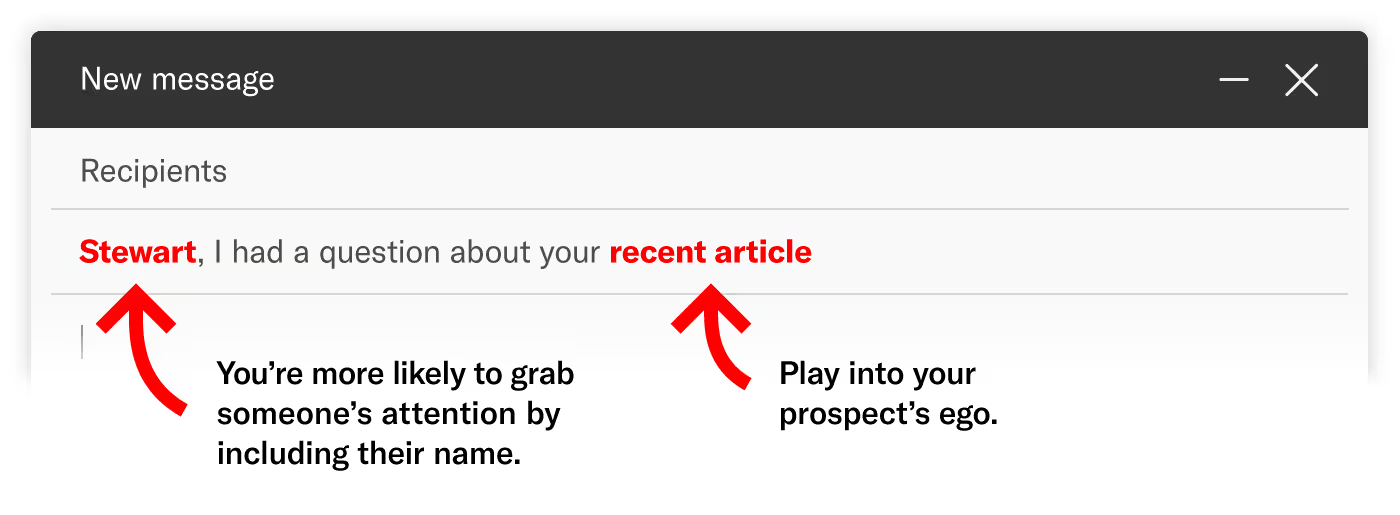
In eight words, the sender conveyed a specific interest in the recipient and demonstrated that they've already invested some time in the potential relationship.
Here’s what a pre-header, or preview text, looks like:
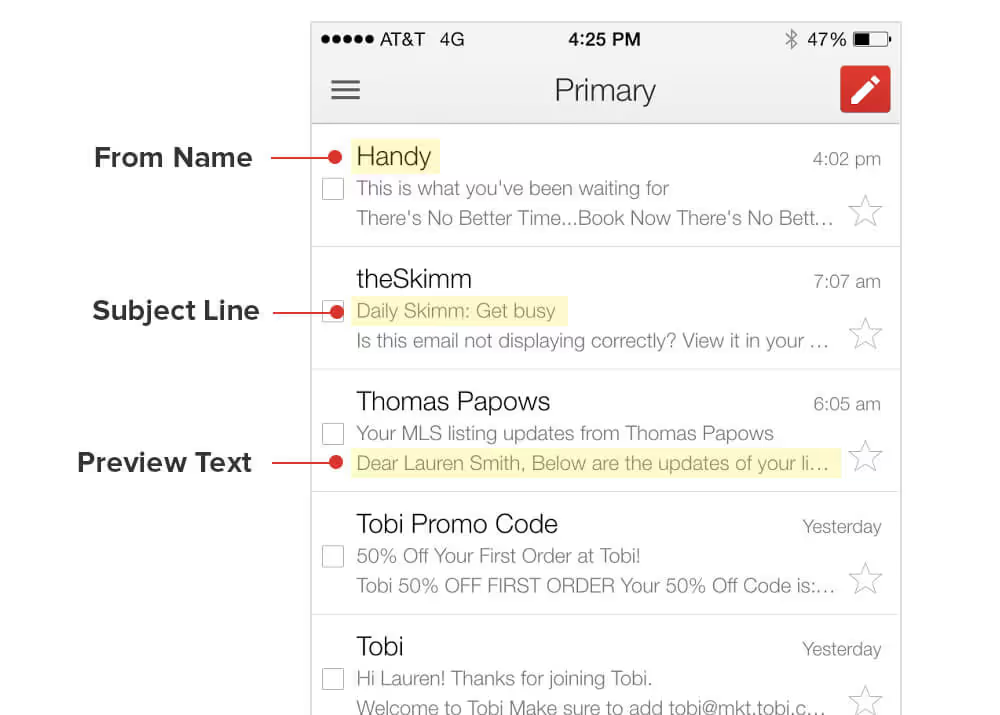
It appears just after the subject line when a recipient is looking at emails in their inbox. Pre-header copy adds context to your subject line and gives the recipient more information.
Keep in mind, too, that 85% of users check email on their smartphones, so you should always consider how to optimize your emails for mobile screens.
So how do you get the pre-header copy right? Here are some guidelines that can help:
Most people don’t think twice about grammar mistakes and typos in personal emails, but with marketing emails…it’s a different story. Such mistakes may not accurately reflect a company’s literacy and attention to detail, but it doesn’t matter.
In a 2022 survey of 50,000 subscribers to its email newsletter, Linguix found that each marketing email with grammar mistakes reduced potential leads by 25%. Ask yourself this, too: How do you feel when you receive a marketing email with grammar mistakes or typos?
Suppose you write an impeccable cold email – great subject line, perfect preheader copy, and body text. You’re ready to send, right?
Wrong.
The final piece of the puzzle for an effective cold outreach email is a call to action (CTA). Even if every other part of your email is spot-on, it’s a rudderless boat without some way of directing your prospect to take the next step toward doing business with your company. And the best way to accomplish this is through an effective CTA.
<div class="anchor-wrapper"><div id="how-to-write-cold-email" class="anchor-target"></div></div>
Let's focus on the core of your email - the message body. These tips will help you write a message that resonates with your recipient and inspires them to take the next step.
Personalization is a crucial aspect of any cold email outreach strategy. Tailoring the tone of the email copy, the type of content, and specific pain points you can solve helps the recipient feel like you wrote the email just for them.
Of course, you can't really write each email individually – at least not at scale. That's where segmentation comes in; it allows you to personalize cold outreach at scale. Segmentation is the process of grouping prospects based on their job title, industry, business size, or other relevant factors and then writing cold emails that best fit each identified segment
Marketers have found that segmenting email campaigns leads to a 760% increase in revenue.
Once you've segmented your email list, create personalized emails for each group.
Most people think personalization only refers to using the prospect’s name in an email. While this certainly plays a part, personalization goes far beyond this simple trick.
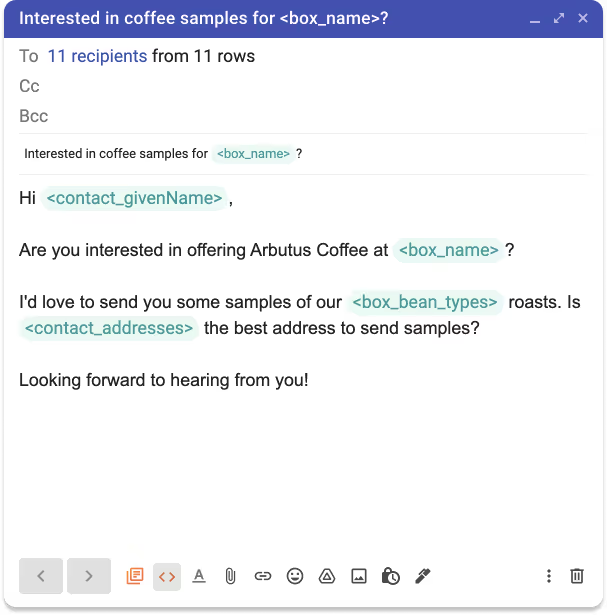
Some ideas of how you can personalize an email include:
Tidbits like these tell the recipient that they’re not on the wrong end of another generic email. Showing you’ve researched the prospect’s company by mentioning their challenges or recent triumphs is another good cold email strategy.
Most CRMs and email marketing tools allow you to enter details about your leads to then use as variables in mail merges and mass emails, which means you can create endlessly personalized mass emails in minutes.
Your email itself shouldn't be endless. Word count is important.
Long, wordy emails are a sure way to get your prospect to click “delete” without ever giving your message a proper read. Research shows that the sweet spot is between 50 and 125 words.
Shorter emails get your point across quickly to a recipient who hasn’t decided to invest time in you yet. That’s why they work.
Of course, your goal is probably to provide more information than 50 - 125 words allow so the prospect understands what you’re offering. In those cases, you could add a tracked link to a page containing all the information.
Alternatively, you can invite the prospect to jump on a call and give an outline (bullet points are your best friend) of what you want to discuss.
Whatever you choose, keep in mind that the golden rule of cold emailing is to “deliver value to the prospect,” so make sure each word counts.
Including the pain point in your cold email is the best way to show your prospects you understand their situation.
To find out your prospect’s pain point, you’ll need to invest time and do some research. That time is well worth it, however, since the prospect can more easily relate to what you’re saying.
Discussing a specific pain point also sets you up to explain precisely how you can help them, changing the email’s tone. Instead of focusing on selling something, you’re solving the prospect’s problem, helping make them feel understood and valued.
When you touch on a prospect’s pain point, you can show how you’ll provide value in a very specific way.
Let’s look at an example:

This example doesn’t include any promotional language. Instead, it states a problem and explains the causes for free.
After the recipient has watched the video, who will be the first person on their mind when they decide they want to resolve the issue?
The average click-through rate for emails sits between 0.7% and 4.4%, depending on your industry. However, top performers can see that number shoot up to an incredible 9-10%.
Following CTA best practices can increase your click-through rate and convince your recipients to take action.
Tried and tested approaches include:

The easiest way to appear inauthentic is to use complicated, over-the-top language and make outlandish promises Here are some examples of outlandish claims that are more likely to elicit an eye roll from your prospective client than a click on your CTA:
How believable are these? Most people see these claims and immediately think "What's the catch?"
On the flip side, you don’t want to be boring or sound like every other cold email coming from a cubicle-dwelling sales rep. Add a personal touch to your email and use simple, direct language.
Take a look at this example that’s lacking personality:
Hi Danny,
I’m John Smith, and I’m the head of marketing at ZZZ.
I was looking over your social media profile, and I feel that my company would be a great fit…
This example tries to be authentic but fails.
It’s generic – John Smith probably sent the same email to a dozen people and merely changed the recipient’s name.
Let’s try this another way and consider the following questions:
Hi Danny,
I’m John Smith, and I’m the head of marketing at ZZZ.
I came across the article on how to improve email response rates that you posted on LinkedIn, and I have to say, I couldn’t agree more. Too many people simply send out generic emails and hope for the best.
That’s actually one of the reasons I’m writing to you…
Doesn’t that sound more authentic?
When you include specific details about your prospect in your emails, you show that you’re genuinely interested in connecting with and helping them.
Humor can be a great icebreaker, but you can’t just drop a random joke and expect to wow your recipient.
Make sure you're weaving in the humor in a way that benefits the overall structure of the email.
Here’s a great example:

The first sentence establishes a shared interest, the commonality we mentioned earlier.
The second sentence subtly reveals that the sender has done their research.
Then comes the joke.
Afterward, they continue with the casual language but get straight to business. They offer social proof and then explain how they can help the prospect.
It’s worth noting that the CTA can be improved because it doesn’t tell the reader what the next step looks like. A better CTA would be: “If you’re game, I’d love to hop on a 15-minute call with you later this week.”
Social proof is evidence that people have used your product or service and found it valuable. This concept leverages the idea that consumers want to purchase products or services because their peers already have.
Vague or overly salesy language can doom the effectiveness of your cold outreach email. Social proof avoids this problem by allowing you to point directly to value..
So how do you offer social proof? Here are the best options:
Adding case studies, for example, can improve your close rate by as much as 70%.
Since the recipient may be unaware of your company, it works best if the examples and success stories involve:
Think of it like this: if you wanted to send a cold outreach email to Nike offering your marketing services, it would be beneficial to show how you’ve improved marketing efforts for another activewear or apparel brand.
Beyond social proof, validating is the next best option, and it works well in tandem with social proofing.
Validating yourself means mentioning any mutual connection you have with the prospect. For example, if you have a common acquaintance, went to the same school, or share a hobby. Beyond mentioning your business name, you want them to see you as human. The more unique the connection, the more likely you are to get a response.
Here’s a good example:

It’s important to remember what a cold email is supposed to achieve – interest.
Immediately launching into a presentation of your product/service is a surefire way to waste an opportunity. The prospect won’t be interested in your company because they don’t know why they should be interested.
For example, bringing up your solution’s expected ROI in a cold email can lower your success rate by 15% – it does nothing to explain how your product/service can actually help solve the recipient’s pressing problems.
At best, it’s meaningless data. At worst, it’s a reason to argue with your assumptions.
Instead, focus on building an emotional connection by:
These four steps steadily build interest so that by the end of the email, the prospect is eager to click on your CTA and learn more.
<div class="anchor-wrapper"><div id="optimize-cold-email-outreach" class="anchor-target"></div></div>
At this point, you know what to include in a cold email and how to write an authentic, personalized message that will grab your prospect’s attention.
You’re one step away from writing and sending your own cold emails. What’s left?
You need to learn how to optimize your campaign or, in other words, how to:
Let’s get started on this final leg.
Before starting an email campaign, learn a few things about your prospects to make sure they match up with your target audience. This includes:
These factors are essential because they help guide your decision-making process when writing your email.
If you realize you should be connecting with somebody else at the company, find the prospect’s email address online or try asking for an introduction.
If you’re offering something valuable, odds are the employee will want to impress their boss by bringing them an exciting new opportunity.
Salespeople spend 21% of their days writing emails, but templates can help streamline the process.
Cold email templates are also an excellent way to ensure consistent messaging from all your team members. Templates work as a blueprint that you can continuously update based on responses. You keep adjusting them until you find the optimum email template.
On the other hand, by using templates, you run the risk of sending impersonal emails that don’t connect with the target audience.
So how do you strike the right balance between the two options?
That brings us to our next tip:
A/B testing is the process of splitting your email list into equal parts and sending each group a variation of the same email to see which performs best.
Think of it like a science experiment for emails - you want to isolate one specific change in each version so you know what’s impacting your results.
You can run A/B tests for:
Before setting up an A/B test, identify the metric you're trying to improve and how you'll measure success for each test. For example, testing a subject line might impact your open rate. Testing a CTA might impact your clickthrough or response rate.
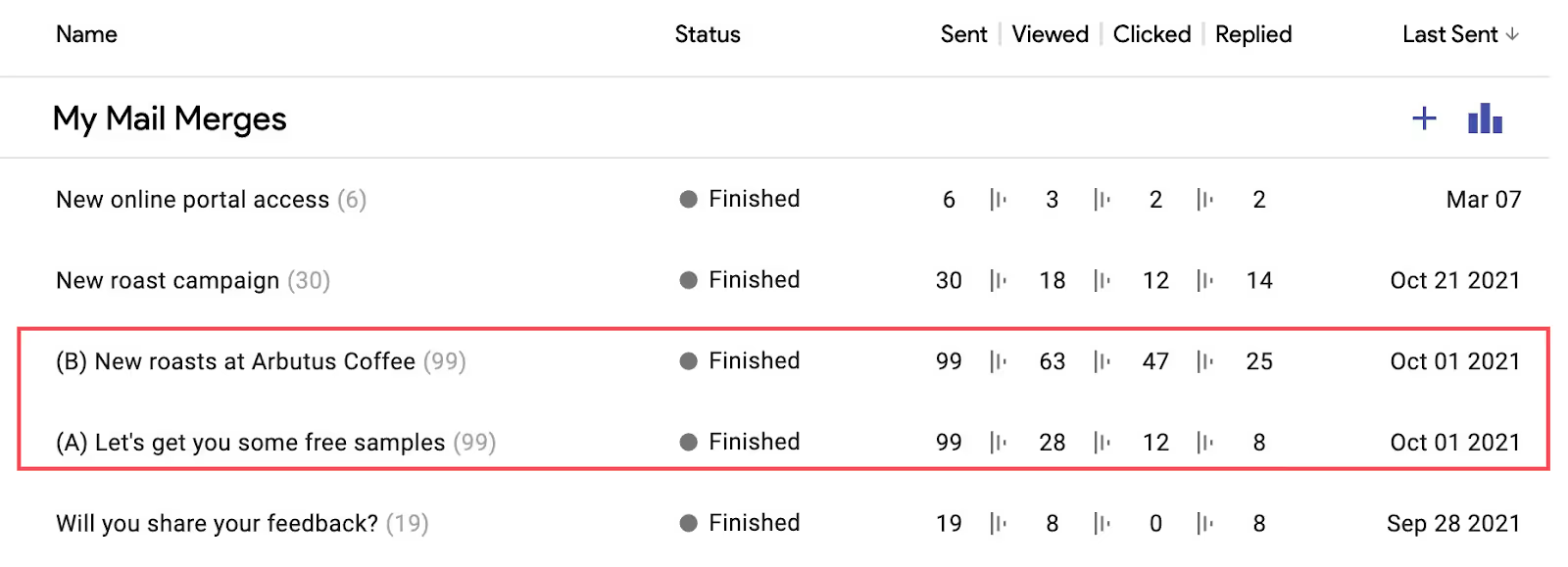
After sending out two or more versions of the same email, analyze your email outreach results. Once you know which version is the most effective, you can use that subject line, CTA, or message in future emails.
Correctly timing your emails can go a long way to helping improve your response rates.
According to a study of over 100,000 emails, the best time of the day to send an email is between 6-9am.
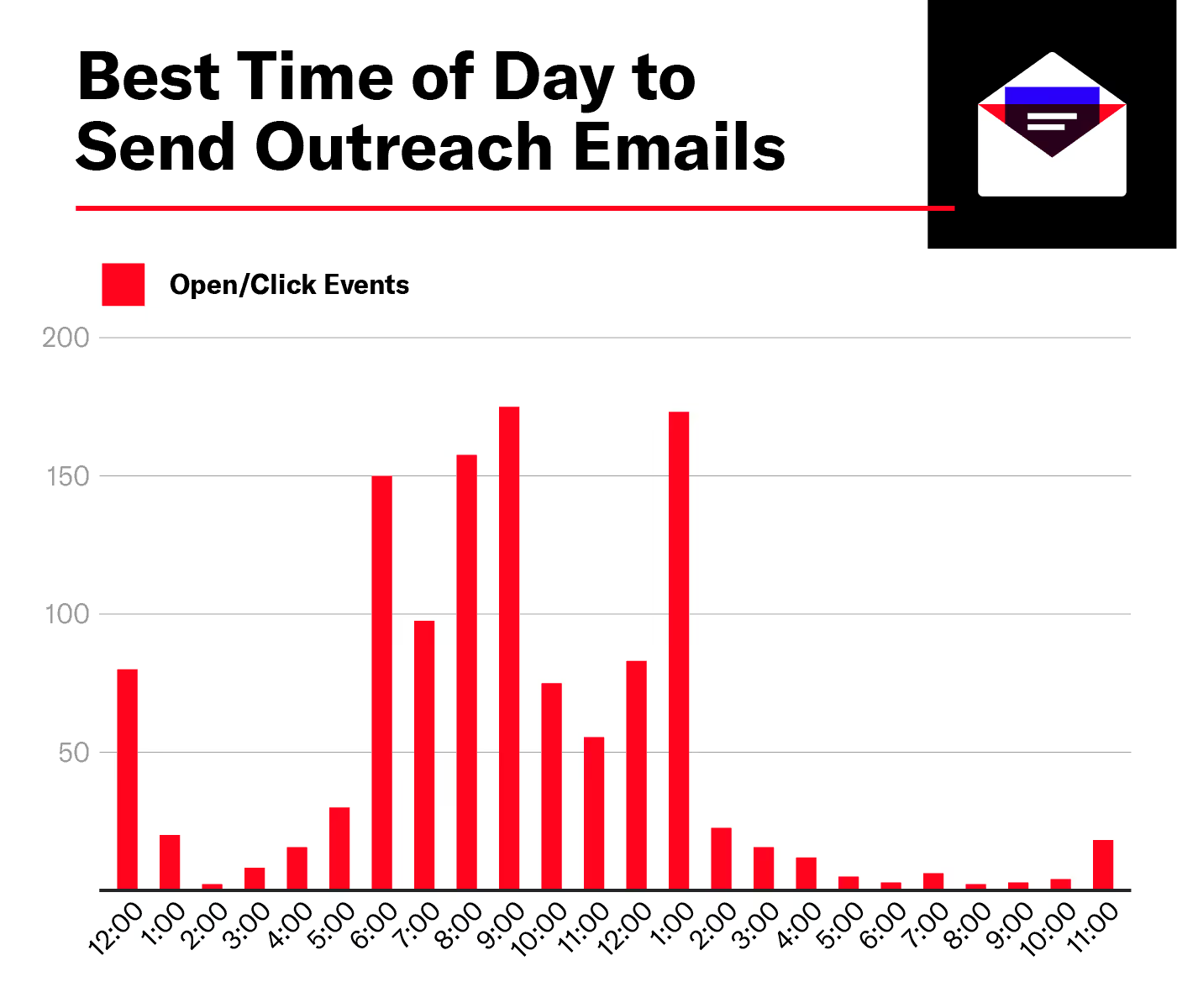
The same study suggests that Monday is the best day to send a cold outreach email, with an open rate of a little over 20%.
Make sure to consider who your audience is as that may affect when they’re most likely to read your emails. For example, a business software company probably isn’t going to reach as many people on the weekend as a fashion brand would.
Email Service Providers (ESPs) use spam filters to protect their users from receiving unwanted and unsolicited emails.
The most common reasons emails go to the spam folder are:
Make sure you're following best practices for email deliverability and avoiding buzzwords that may land you in spam folders.
Only 2% of sales are made during the first point of contact, yet for some reason:
These stats are even more astonishing when you consider that cold email campaigns with four to seven email sequences get three times as many responses as those with fewer than four emails.
In short, it pays to follow up on your cold emails. You’ll want to immediately follow up after your first contact and schedule a follow-up email sequence in case you still don’t get a response.
Some email outreach tools allow you to send automated follow-ups if you don't get a response from your lead. Once the lead responds, they're removed from the follow-up sequence so you can respond to them personally.
Cold emailing is legal, but in the United States, the CAN-SPAM Act gives email recipients the right to stop receiving unsolicited emails and includes fines for any violations.
Here's a non-exhaustive list of how to stay compliant and avoid being marked as spam:
Some marketers (and creatives, too) feel ill at ease with the growing influence of artificial intelligence (AI). Such anxiety is largely unwarranted, though.
AI should be viewed as more of a tool than a threat – a tool that can crunch and analyze enormous quantities of data at mind-numbing speeds. What’s more, it can perform such analyses and calculations with virtually flawless precision.
This enormous capacity not only saves marketers time and effort searching for trends and patterns, but can also uncover data points that would otherwise never be spotted. As a result, AI can make the process of grouping recipients and determining what messages to send to whom and when much more efficient and effective.
These aren’t AI’s only potential uses in regards to cold emailing, but to take advantage of any of the benefits, you must get comfortable and familiar with the technology. The other option is falling behind other marketers who’ve embraced AI not as master, but as cutting-edge technology that makes the job easier and more successful.
<div class="anchor-wrapper"><div id="get-creative-and-scientific" class="anchor-target"></div></div>
Cold emailing is both an art and a science. Sometimes the most creative approaches are the ones that get through to leads, but you'll want to test various tactics to see what works and resonates with your audience. That’s where A/B testing enters the picture; this tactic can be a powerful, effective means for determining what messages resonate with your target prospects and are more likely to lead to clicks on your email CTAs.
Use these tips to start drafting cold emails. AI can help with this, but remember it’s not the writer/marketer, but only a tool. Next, set up some A/B tests to hone in on what's working and what can be improved. Again, AI can help in this process, too, helping narrow down potential messages for testing from larger pools.
Remember that progress can be slow; however, with enough data, sufficient patience – remember, failure is the best teacher – and AI as a tool, you'll eventually find what works for you and start seeing results.
Good luck and happy emailing!
